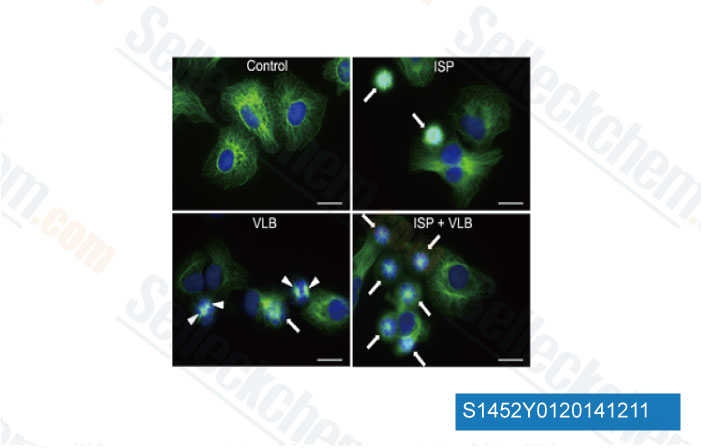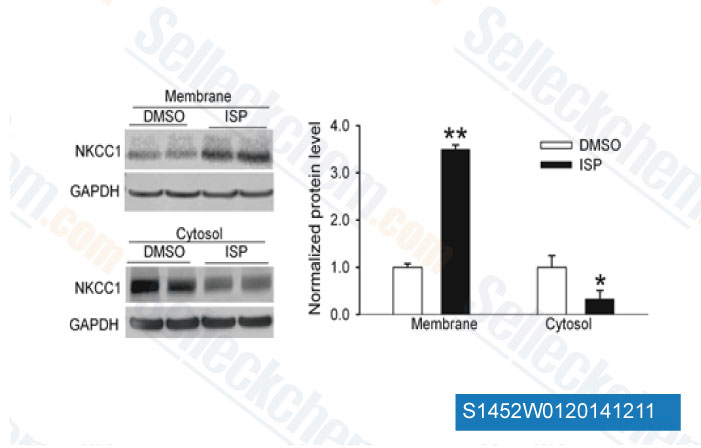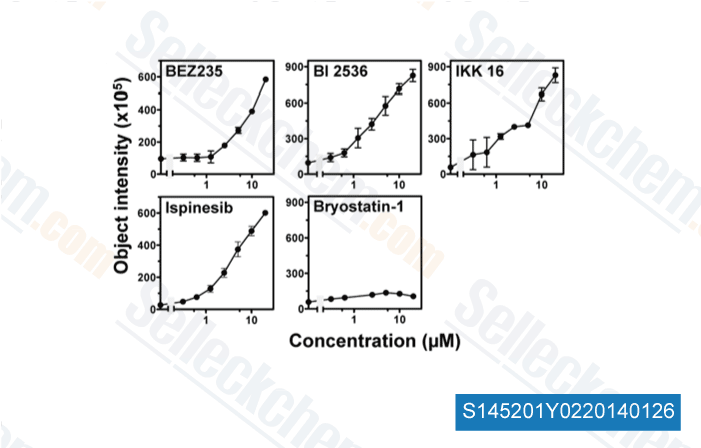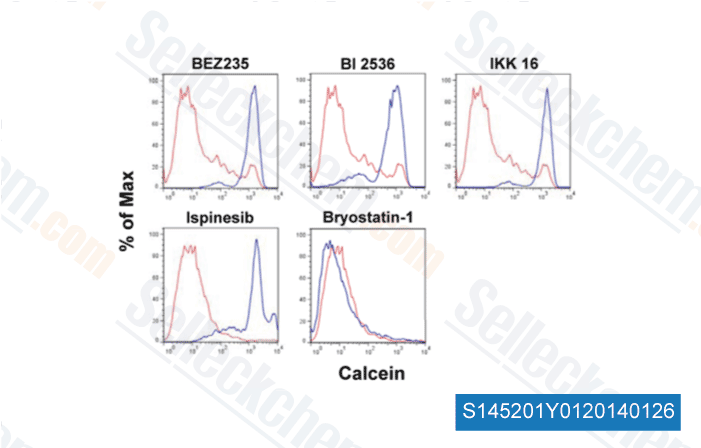|
Toll Free: (877) 796-6397 -- USA and Canada only -- |
Fax: +1-832-582-8590 Orders: +1-832-582-8158 |
Tech Support: +1-832-582-8158 Ext:3 Please provide your Order Number in the email. |
Technical Data
| Formula | C30H33ClN4O2 |
|||
| Molecular Weight | 517.06 | CAS No. | 336113-53-2 | |
| Solubility (25°C)* | In vitro | DMSO | 103 mg/mL (199.2 mM) | |
| Ethanol | 103 mg/mL (199.2 mM) | |||
| Water | Insoluble | |||
|
* <1 mg/ml means slightly soluble or insoluble. * Please note that Selleck tests the solubility of all compounds in-house, and the actual solubility may differ slightly from published values. This is normal and is due to slight batch-to-batch variations. * Room temperature shipping (Stability testing shows this product can be shipped without any cooling measures.) |
||||
Preparing Stock Solutions
Biological Activity
| Description | Ispinesib (SB-715992, CK0238273) is a potent, specific and reversible inhibitor of kinesin spindle protein (KSP) with Ki app of 1.7 nM in a cell-free assay, no inhibition to CENP-E, RabK6, MCAK, MKLP1, KHC or Kif1A. Ispinesib induces mitotic arrest and apoptotic cell death. | ||
|---|---|---|---|
| Targets |
|
||
| In vitro | Ispinesib is a potent, allosteric, reversible, and specific inhibitor of KSP, which changes the binding property of KSP to microtubules and disturbs its movement by inhibiting ADP release without altering the release of the KSP-ADP complex from the microtubule. [1] Ispinesib shows potent cytotoxic activity in a panel of tumor cell lines, including Colo205, Colo201, HT-29, M5076, Madison-109, and MX-1, with IC50 of 1.2 nM to 9.5 nM. [2] In PC-3 prostate cancer cells, Ispinesib (15 nM and 30 nM) blocks cell proliferation and induces apoptosis by regulating the expression levels of genes that controls apoptosis, cell proliferation, cell cycle, and cell signaling, such as EGFR, p27, p15, and IL-11. [3] In a panel of 53 breast cell lines, Ispinesib (7.4 nM–600 nM) demonstrates broad inhibitory activity. In BT-474 and MDA-MB-468 cells, Ispinesib (150 nM) induces apoptosis, as revealed by a higher proportion of apoptotic cells, lower antiapoptotic Bcl-XL level, and higher proapoptotic Bax and Bid levels. [4] |
||
| In vivo | Ispinesib (4.5 mg/kg–15 mg/kg) exhibits inhibitory effects against Colo205, Colo201, HT-29, but not MX-1 cells, in mouse xenograft models. SB-715992 (6 mg/kg–10 mg/kg ) also inhibits murine solid tumors, including Madison 109 lung carcinoma, M5076 sarcoma, as well as L1210 and P388 leukemias. [2] In mice xenograft models of breast cancer cells MCF-7, HCC1954, MDA-MB-468, and KPL4, Ispinesib (8 mg/kg–10 mg/kg) inhibits tumor growth. [4] |
||
| Features | An allosteric, potent, specific, and reversible inhibitor of the mitotic kinesin spindle protein (KSP) (HsEg5). |
Protocol (from reference)
| Kinase Assay: |
|
|---|---|
| Cell Assay: |
|
| Animal Study: |
|
References
Customer Product Validation

-
Data from [Data independently produced by Mol Oncol, 2014, 8(8), 1548-60]

-
Data from [Data independently produced by J Biol Chem, 2014, 289(45), 31111-20]

-
Data from [PLoS One, 2013, 8(4), e60334]

-
Data from [PLoS One, 2013, 8(4), e60334]
Selleck's Ispinesib (SB-715992) has been cited by 27 publications
| Small-molecule inhibition of kinesin KIF18A reveals a mitotic vulnerability enriched in chromosomally unstable cancers [ Nat Cancer, 2024, 5(1):66-84] | PubMed: 38151625 |
| E3 ubiquitin ligase ASB8 promotes selinexor-induced proteasomal degradation of XPO1 [ Biomed Pharmacother, 2023, 160:114305] | PubMed: 36731340 |
| Improving Localized Radiotherapy for Glioblastoma via Small Molecule Inhibition of KIF11 [ Cancers (Basel), 2023, 15(12)3173] | PubMed: 37370783 |
| The Global Phosphorylation Landscape of SARS-CoV-2 Infection [ Cell, 2020, 182(3):685-712.e19] | PubMed: 32645325 |
| The Global Phosphorylation Landscape of SARS-CoV-2 Infection [ Cell, 2020, 182(3):685-712.e19] | PubMed: 32645325 |
| Therapeutic targeting of KSP in preclinical models of high-risk neuroblastoma [ Sci Transl Med, 2020, 12(562)eaba4434] | PubMed: 32967973 |
| enAsCas12a Enables CRISPR-Directed Evolution to Screen for Functional Drug Resistance Mutations in Sequences Inaccessible to SpCas9 [ Mol Ther, 2020, S1525-0016(20)30482-2] | PubMed: 33002419 |
| Enhancing Brain Retention of a KIF11 Inhibitor Significantly Improves its Efficacy in a Mouse Model of Glioblastoma. [ Sci Rep, 2020, 16;10(1):6524] | PubMed: 32300151 |
| KIF11 and KIF15 mitotic kinesins are potential therapeutic vulnerabilities for malignant peripheral nerve sheath tumors [ Neurooncol Adv, 2020, 2(Suppl 1):i62-i74] | PubMed: 32642733 |
| Allele-selective lowering of mutant HTT protein by HTT-LC3 linker compounds [ Nature, 2019, 575(7781):203-209] | PubMed: 31666698 |
RETURN POLICY
Selleck Chemical’s Unconditional Return Policy ensures a smooth online shopping experience for our customers. If you are in any way unsatisfied with your purchase, you may return any item(s) within 7 days of receiving it. In the event of product quality issues, either protocol related or product related problems, you may return any item(s) within 365 days from the original purchase date. Please follow the instructions below when returning products.
SHIPPING AND STORAGE
Selleck products are transported at room temperature. If you receive the product at room temperature, please rest assured, the Selleck Quality Inspection Department has conducted experiments to verify that the normal temperature placement of one month will not affect the biological activity of powder products. After collecting, please store the product according to the requirements described in the datasheet. Most Selleck products are stable under the recommended conditions.
NOT FOR HUMAN, VETERINARY DIAGNOSTIC OR THERAPEUTIC USE.
